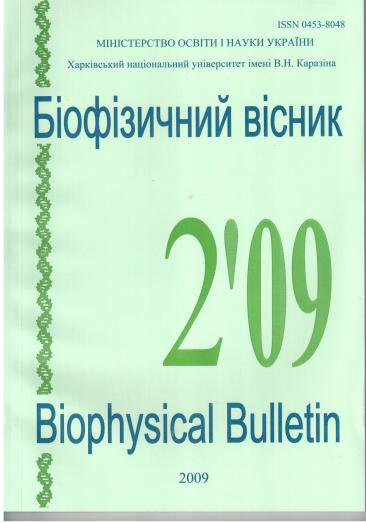Інтенсивності смуг низькочастотного спектру кр ДНК з легкими та важкими протиіонами
Анотація
Для розрахунку інтенсивностей смуг низькочастотного спектру комбінаційного розсіяння ДНК в
даній роботі розвинуто підхід, що ґрунтується на валентно-оптичній схемі та моделі чотирьох мас
для описання конформаційних коливань подвійної спіралі. В рамках запропонованого підходу
обґрунтовано, що коливання нуклеозидів як фізичних маятників відносно фосфатних груп остова
макромолекули та внутрішньонуклеозидні деформаційні коливання призводять до найбільших
змін поляризовності мономерної ланки ДНК. Розрахунки для Na- та Cs-ДНК показали, що в обох
випадках найбільшу інтенсивність в низькочастотному спектрі комбінаційного розсіяння мають
моди, що характеризують коливання нуклеозидів як фізичних маятників поблизу 15 см-1.В діапазоні від 40 см-1 в спектрі Na-ДНК найбільш інтенсивними є моди розтягу водневих зв’язків в
парах азотистих основ 60 та 115 см-1, в той час як внутрішньонуклеозидні коливання 79 см-1 мають
меншу інтенсивність. При врахуванні гетерогенності структурних елементів подвійної спіралі
результуюча форма центральної частини низькочастотного спектру Na-ДНК набуває вигляду
суцільної смуги з центром біля 80 см-1, що повністю узгоджується з експериментальними даними.
У випадку Cs-ДНК в цьому діапазоні спектру суттєво виділяється мода іон-фосфатних коливань
поблизу 115 см-1, інтенсивність якої значно більша, ніж інтенсивність мод Na-ДНК, що, знаходяться
поблизу 100 см-1. Інтенсивності інших мод Cs-ДНК значно менші, ніж у Na-ДНК.Співставлення теорії з експериментом показало, що розвинутий підхід добре описує спостережувані зміни низькочастотних спектрів комбінаційного розсіяння ДНК при заміні протиіонів Na+ на Cs+. Виявлена чутливість інтенсивності низькочастотних спектрів до сорту протиіонів підтверджує існування моди іон-фосфатних коливань в коливальній динаміці ДНК.
Завантаження
Посилання
2. Благой Ю.П., Галкин В.Л., Гладченко Г.О., Корнилова С.В., Сорокин В.А., Шкорбатов А.Г. Металлокомплексы нуклеиновых кислот в растворах. – Киев: Наукова думка, 1991.
3. Baumann C.G., Smith S.B., Bloomfield V.A., Bustamante C. // Proc. Natl. Acad. Sci. USA. 1997. V. 94. P. 6185 – 6190.
4. Williams L.D., Maher L.J. // Annu. Rev. Biophys. Biomol. Struct. 2000. V. 29. P. 497–521.
5. Kornyshev A.A., Lee D.J., Leikin S., Wynveen A. // Rev. Mod. Phys. 2007. V. 79. P. 943-966. 6. Manning G. S. // Quart. Rev. Biophys. 1978. V. 11, № 2. P. 179 - 246.
7. Франк-Каменецкий М.Д., Аншелевич В.В., Лукашин А.В. // УФН. 1987. V. 151, № 4. P. 595 - 618.
8. Das R., Mills T.T., Kwok L.W., Maskel G.S., Millett I.S., Doniach S., Finkelstein K.D., Herschlag D., Pollack L. // Phys. Rev. Lett. 2003. V. 90, № 18. P. 188103-1 – 188103-4.
9. Ponomarev S.Y., Thayer K.M., Beveridge D.L. // Proc. Natl. Acad. Sci. USA 2004. V. 101. P. 14771– 14775.
10. Varnai P., Zakrzewska K. // Nucleic Acids Res. 2004. V. 32. P. 4269–4280.
11. Gu B., Zhang F.S., Wang Z.P., Zhou H.Y. // Phys. Rev. Lett. 2008. V. 100. P. 088104-1 – 088104-4.
12. Волков С.Н., Косевич А.М. // Молекулярная биология 1987. Т. 21. С. 797 - 8 06.
13. Волков С.Н., Косевич А.М., Вайнреб Г. Е. // Биополимеры и клетка 1989. Т. 5. С. 32 - 39.
14. Volkov S.N., Kosevich A.M. // J. Biomolec. Struct. Dyn. 1991. V. 8. P. 1069 - 1083.
15. Perepelytsya S.M., Volkov S.N. // Ukr. J. Phys. 2004. Т. 49. С. 1072 - 1077. arXiv:q-bio/0412022v1 [q1- bio.BM]
16. Перепелица С.Н., Волков С.Н. // Біофізичний вісник. 2005. Т.1(15). C. 5 - 10.
17. Perepelytsya S.M., Volkov S.N. // Eur. Phys. J. E. 2007. V. 24. P. 261 - 269.
18. Weidlich T., Powell J.W., Genzel L., Rupprecht A. // Biopolymers. 1990. V. 30. P. 477 - 480.
19. Булавін Л.А., Волков С.Н., Кутовий С.Ю., Перепелиця С.М. // Доп. НАН України. 2007. № 10. С. 69 - 73. arXiv:0805.0696v1 [q-bio.BM]
20. Волькенштейн М.В., Ельяшевич М.А, Степанов Б.И. Колебания молекул. Т.2. – Москва: ГИТТЛ, 1949.
21. Snoke D.W., Cardona M. // Solid State Commun. 1993. V. 87, № 2. P. 121 – 126.
22. Dykeman E.C., Sankey O.F, Tsen K.-T. // Phys. Rev. E. 2007. V. 76. P. 011906-1 – 011906-12.
23. Dykeman E.C., Sankey O.F. // Phys. Rev. Lett. 2008. V. 100. P. 028101-1 – 028101-4.
24. Федорченко А.М. Теоретична фізика. Механіка. Київ: Вища школа, 1971.
25. Silberstein L. // Philosophy Magazine 1917. V. 33. P. 92.
26. Urabe H., Tominaga Y. // J. Phys. Soc. Japan. 1981. V. 50, № 11. P. 3543 - 3544.
27. Rozenberg H., Rabinovich D., Frolow F., Hegde R. S., Shaked Z. // Proc. Natl. Acad. Sci. USA. 1998. V. 95. P. 15194 - 15199.
28. Верещагин А.Н. Поляризуемость молекул.-Москва: Наука, 1980.
29. Lamba Om P., Wang A.H.-J., Thomas G.J.Jr, // Biopolymers. 1989. V. 28. P. 667 - 678.
30. Weidlich T., Lindsay S.M., Rui Qi, Rupprecht A. // J. Biomolec.Struct. Dyn. 1990. V. 8. P. 139 - 171.
31. Tominaga Y., Shida M., Kubota K., Urabe H., Nishimura Y., Tsuboi M. // J. Chem. Phys. 1985. V. 83,
№ 11. P. 5972 - 5975.
Автори, які публікуються у цьому журналі, погоджуються з наступними умовами:
- Автори залишають за собою право на авторство своєї роботи та передають журналу право першої публікації цієї роботи на умовах ліцензії Creative Commons Attribution License, котра дозволяє іншим особам вільно розповсюджувати опубліковану роботу з обов'язковим посиланням на авторів оригінальної роботи та першу публікацію роботи у цьому журналі.
- Автори мають право укладати самостійні додаткові угоди щодо неексклюзивного розповсюдження роботи у тому вигляді, в якому вона була опублікована цим журналом (наприклад, розміщувати роботу в електронному сховищі установи або публікувати у складі монографії), за умови збереження посилання на першу публікацію роботи у цьому журналі.
- Політика журналу дозволяє і заохочує розміщення авторами в мережі Інтернет (наприклад, у сховищах установ або на особистих веб-сайтах) рукопису роботи, як до подання цього рукопису до редакції, так і під час його редакційного опрацювання, оскільки це сприяє виникненню продуктивної наукової дискусії та позитивно позначається на оперативності та динаміці цитування опублікованої роботи (див. The Effect of Open Access).





